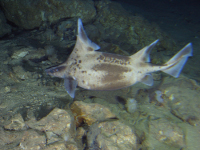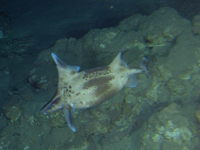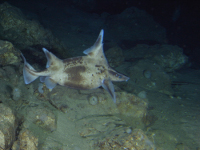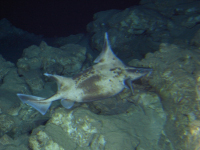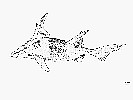Oxynotus caribbaeus
Cervigón, 1961
Caribbean roughshark
Classification: Elasmobranchii Squaliformes Oxynotidae
Reference of the original description
Una nueva especie de Oxynotus de las costas de Venezuela (Elasmobranchii - Selachii). Novedades cientificas. Serie zoológica. Museo de Historia Natural La Salle, 27: 1–10
Una nueva especie de Oxynotus de las costas de Venezuela (Elasmobranchii - Selachii). Novedades cientificas. Serie zoológica. Museo de Historia Natural La Salle, 27: 1–10
Image of the original description
Image in copyright.
Image in copyright.
Description :
Citation: Oxynotus caribbaeus Cervigón, 1961: In: Database of modern sharks, rays and chimaeras, www.shark-references.com, World Wide Web electronic publication, Version 01/2026
Please send your images of "Oxynotus caribbaeus" to info@shark-references.com
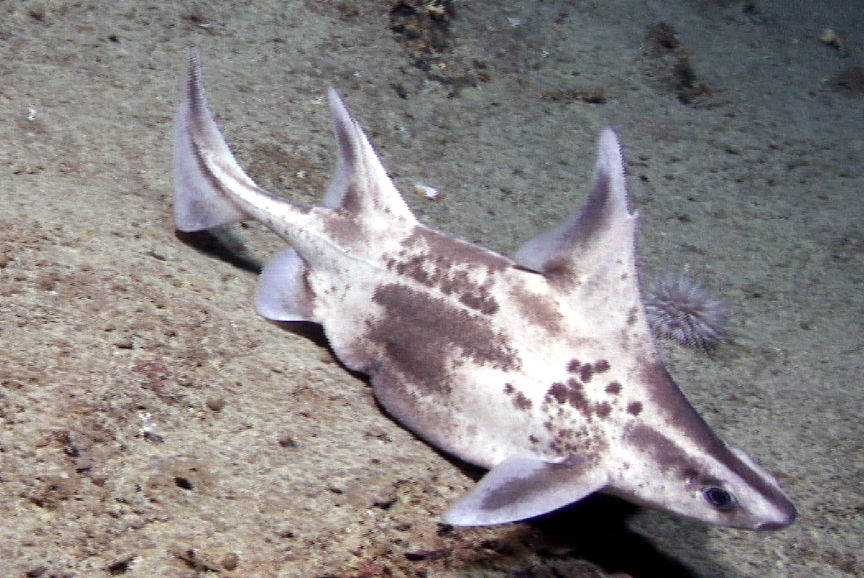
Oxynotus caribbaeus Cervigón, 1961, from the specimen (TL ca 50, 0 cm, observed 30.09.2011) from an ROV off Key West, Florida © NOAA/CIOERT
Thank's to Charles G. Messing, Nova Southeastern University, for providing the image

Oxynotus caribbaeus Cervigón, 1961, from the specimen (TL ca 50, 0 cm, observed 30.09.2011) from an ROV off Key West, Florida © NOAA/CIOERT
Thank's to Charles G. Messing, Nova Southeastern University, for providing the image
Common names
 Tiburón ojinoto,
Tiburón ojinoto,  Centrine antillaise,
Centrine antillaise,  Caribbean roughshark
Caribbean roughshark
 Tiburón ojinoto,
Tiburón ojinoto,  Centrine antillaise,
Centrine antillaise,  Caribbean roughshark
Caribbean roughshark
Short Description
Spiracle small and circular. Supraorbital ridges not greatly expanded and not forming a knob in front of spiracles. Apices of dorsal fins narrowly triangular, posterior margins strongly concave; first dorsal spine inclined forward. Colour grey or brownish, with dark blotches and small spots on head, body, tail, and fins, separated by prominent light areas over pectoral and pelvic fins. [518]
Spiracle small and circular. Supraorbital ridges not greatly expanded and not forming a knob in front of spiracles. Apices of dorsal fins narrowly triangular, posterior margins strongly concave; first dorsal spine inclined forward. Colour grey or brownish, with dark blotches and small spots on head, body, tail, and fins, separated by prominent light areas over pectoral and pelvic fins. [518]
Distribution
Western Central Atlantic: Venezuela, possibly elsewhere in the Caribbean.
Records:
20./21.10.1963 by the U. S. Fish and Wildlife Service, Bureau of Commercial Fisheries exploratory on Cruise 87, vessel OREGON off the coast of Venezuela (27 miles southeast of Blanquilla Island, 20 miles east of Margarita Island at 11°23' N, 64°25' W, and 11°24' N, 64°25' W, in 402 and 429 m) (immature male and female, were 201 mm and 212 mm; collection nr.: United States National Museum (USNM 188876) and at Stanford University (SU 62404)) [2811];
1991, in the southern Gulf of Mexico off Alacrán Reef, northwest of Yucatán (22°32'N, 90°54'W), from a depth of 412.5 m (male, 42,6 cm TL) [22760]; 04.05.1989 off Soufriere (Grand Caille Point), St. Lucia, West Indies (Johnson Sea-Link submersible dive 1763) (immature female, 520 mm TL), video of a specimen off Grand Bahama Island (CGM) [19752]
off Honduras, on the Cayman Trench off the northwest coast of the Island of Roatan (pers. comment Fernando M. Garces, see images); Source: www.gbif.org
Western Central Atlantic: Venezuela, possibly elsewhere in the Caribbean.
Records:
20./21.10.1963 by the U. S. Fish and Wildlife Service, Bureau of Commercial Fisheries exploratory on Cruise 87, vessel OREGON off the coast of Venezuela (27 miles southeast of Blanquilla Island, 20 miles east of Margarita Island at 11°23' N, 64°25' W, and 11°24' N, 64°25' W, in 402 and 429 m) (immature male and female, were 201 mm and 212 mm; collection nr.: United States National Museum (USNM 188876) and at Stanford University (SU 62404)) [2811];
1991, in the southern Gulf of Mexico off Alacrán Reef, northwest of Yucatán (22°32'N, 90°54'W), from a depth of 412.5 m (male, 42,6 cm TL) [22760]; 04.05.1989 off Soufriere (Grand Caille Point), St. Lucia, West Indies (Johnson Sea-Link submersible dive 1763) (immature female, 520 mm TL), video of a specimen off Grand Bahama Island (CGM) [19752]
off Honduras, on the Cayman Trench off the northwest coast of the Island of Roatan (pers. comment Fernando M. Garces, see images); Source: www.gbif.org
Human uses
fisheries: of no interest
fisheries: of no interest
Biology
Distinct pairing with embrace [17086]. Found on the upper continental slopes. Bottom temperatures range from 9.4 to 11.1°C. Probably feeds on bottom invertebrates and fishes.
Distinct pairing with embrace [17086]. Found on the upper continental slopes. Bottom temperatures range from 9.4 to 11.1°C. Probably feeds on bottom invertebrates and fishes.
Habitat
bathydemersal; marine; depth range 402 - 457 m
bathydemersal; marine; depth range 402 - 457 m
Remarks
shark-references Species-ID=4477;
shark-references Species-ID=4477;








